The following Timeline article with photos was emailed to United Poultry Concerns on January 29, 2015 as follows:
Greetings — here’s an article on industrial chicken production that’s posted to our front page today— the writer used a lot of great information published by United Poultry Concerns, thank you.
Paul Spinrad
Features Editor, Timeline
Super-Sizing the Chicken
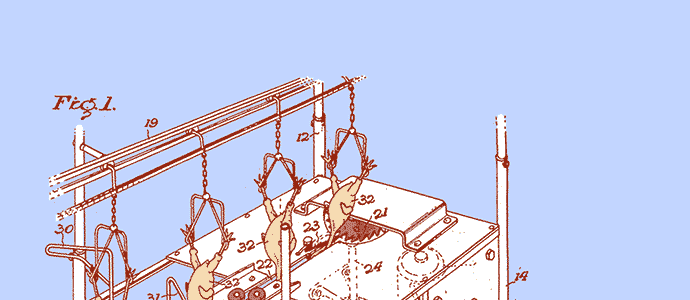
1923 - PRESENT
BRIEF
Chickens have been domesticated for thousands of years, but they’ve changed a lot since the 1920s.
For starters, a “broiler” (a chicken raised for meat) then took 16 weeks of care to reach a sellable weight of 2.5 pounds. Today’s
breeds can reach double that weight in half the time, thanks to selective breeding and a growth-optimizing diet.
Roughly 9 billion broilers are
raised per year in the US, many in sheds that can hold upwards of 10,000 birds each.
So how did the Great Depression dream of “a chicken in every pot” become a
reality?
1923
First broiler house founded
Oceanview, DE
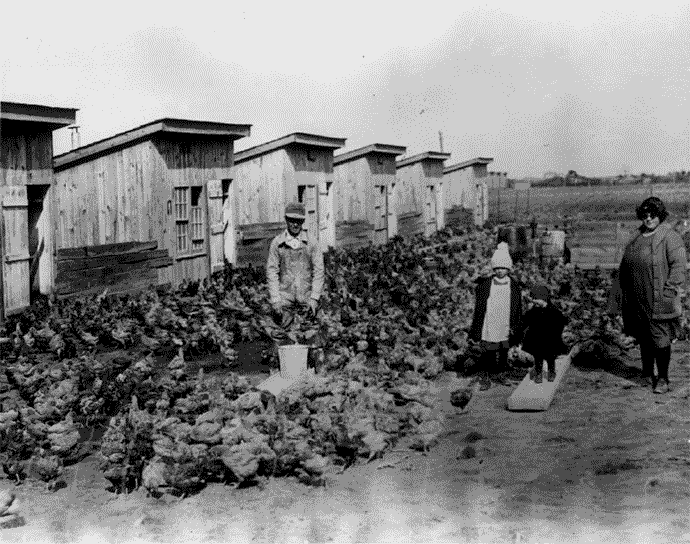
The Steele family with their broiler operation in 1924.
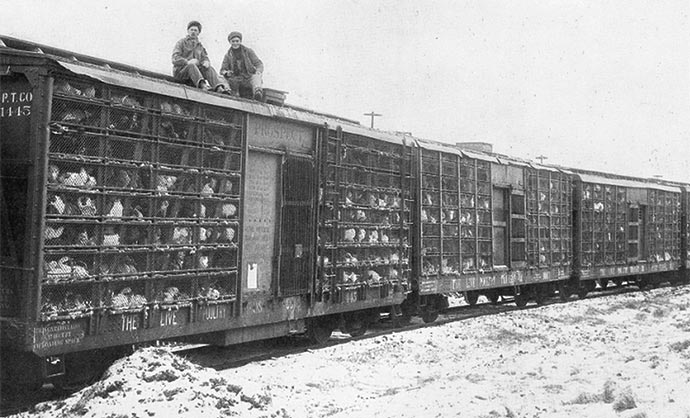
As the industry expanded, broiler chickens were distributed, live, by poultry train.
© US Department of Agriculture
The first large-scale broiler entrepreneur in the US got her start thanks to a shipping error.
Cecilia Steele, the wife of a Coast Guardsman, ordered 50 chicks to raise as laying hens, but erroneously received 500. She raised them all, and after 387 of the birds survived to be two pounds each, she sold them as meat for a whopping for 67 cents a pound. The next year Steele ordered another 1,000, and by 1926 she was raising 10,000 broilers.
1930s
Beak trimming technique developed
Wooster, OH
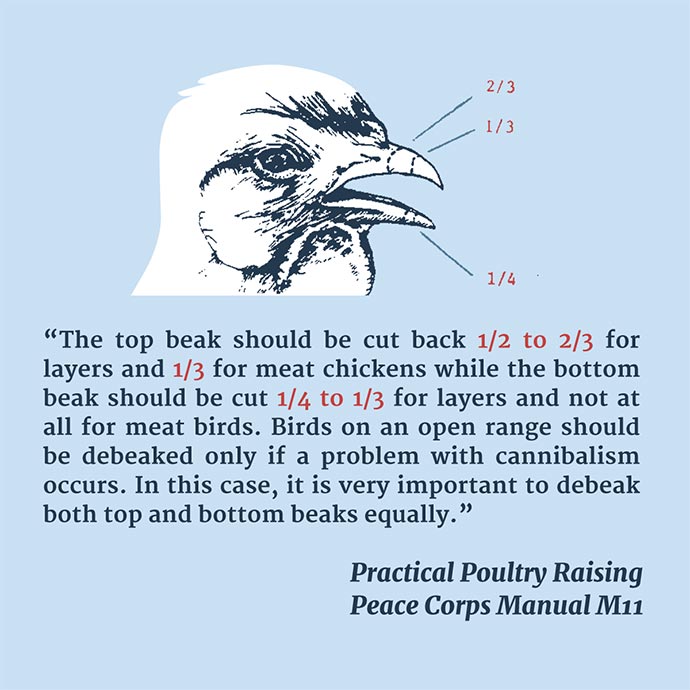
The very tip of the chicken beak was trimmed by hand. © Christopher Dang/Timeline.com
Chickens are social creatures that naturally do best in groups of fewer than 90. More than that and it’s hard for them to establish a pecking order, so they might peck one another repeatedly to the point of injury or death.
To prevent such damage, if not the underlying behavior, farmers at the Ohio Agricultural Experiment Station started hand-trimming a
quarter-inch off the beak. Beak-trimming is still performed today via more automated methods when raising chickens at industrial scale.
1946 - 1948
“Chicken of Tomorrow” contest sets trend
Fayetteville, AR
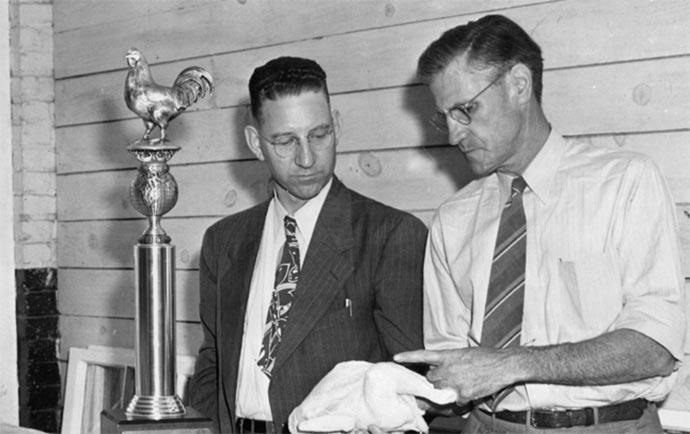
The winner of the North Carolina contest in 1947 © North Carolina State University
The country’s largest supermarket chain, the Great Atlantic & Pacific Tea Company (A&P), sponsored a national contest in search
of the “Chicken of Tomorrow” which began not on the Atlantic nor the
Pacific, but in Arkansas.
The contest prized a broiler breed with a high feed-to-weight conversion that was “broader breasted…with bigger drumsticks, jucier
thighs, and layers of white meat.” The first-prize went to a Cornish-White Rock mix from North Carolina.
1957
Poultry production vertically integrated
Georgetown, DE
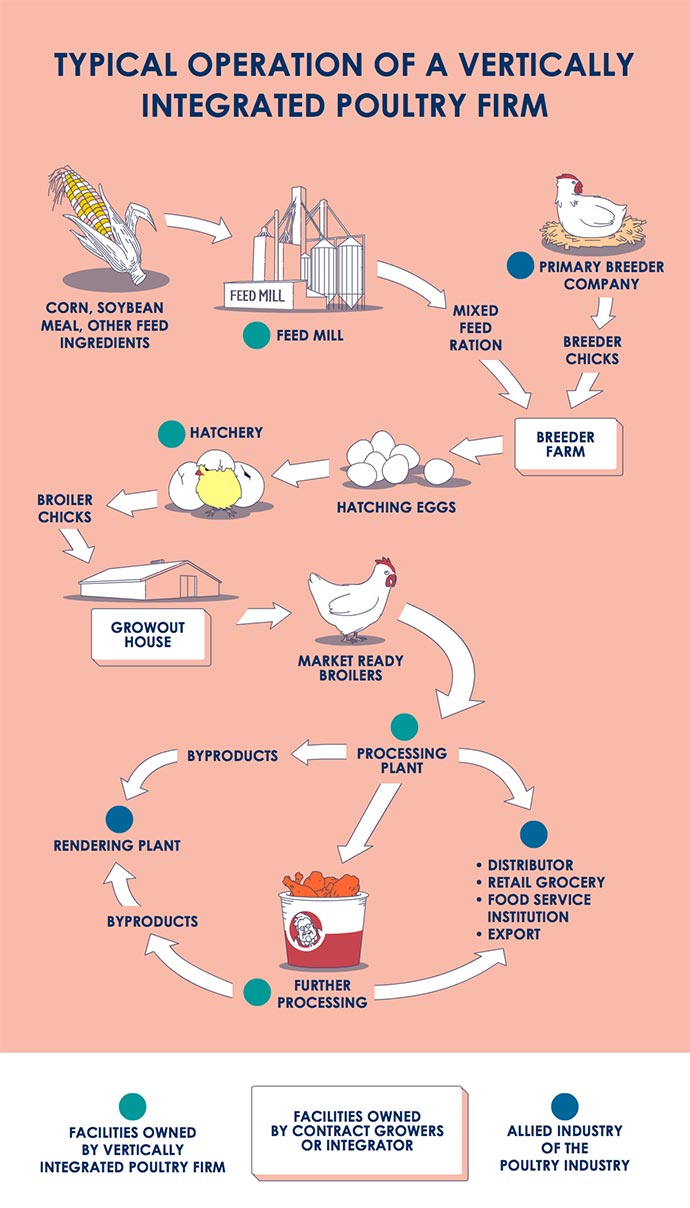
Flow chart depicting a typical vertically integrated broiler company.
© Christopher Dang/Timeline.com
The chicken industry was originally fed by companies with different specialties, such as hatcheries, farms and processing plants. In the 1940s,
entrepreneurs started to combine production stages and brought their supply chains under the same roof.
The first company to integrate fully was Townsend’s in 1957, followed closely by broiler giant Tyson. By the 1960s, 90% of chicken meat
would come from integrated operations.
DECEMBER 31, 1968
Distorting contact lenses for fowl patented
Santa Rosa, CA
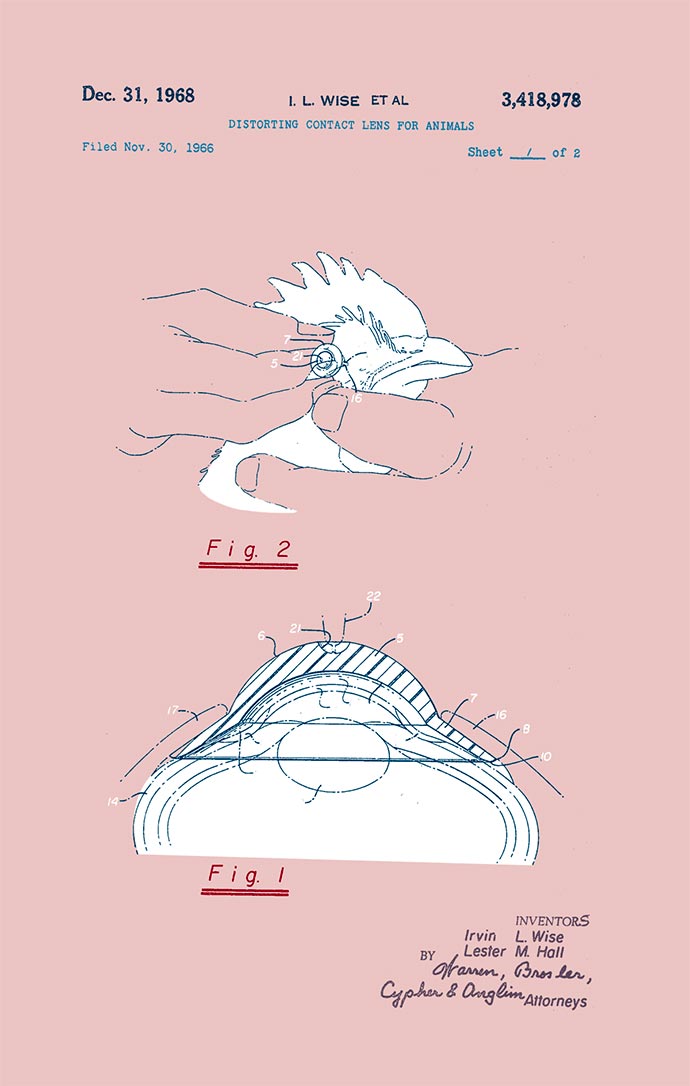
Injection-molded thermoplastic resin contact lenses calm chickens down.
© Christopher Dang/Timeline.com
Inventors Irvin Wise and Lester Hall developed a contact lens that creates harmony among densely packed chickens by reducing the clarity with
which they can see. Sometimes the lenses even eliminated the need to debeak the birds. Red-tinted versions later became a standard method for
increasing the efficiency of chicken and egg production.
”
When applied to chickens they reduce food waste, expenditure of energy, noise, injuries, and resultant disease, dust and egg breakage, promote
contentment and harmony, and increase the production of eggs.
US PATENT #3418978,
BY IRVIN L WISE, LESTER M HALL, VISION CONTROL INC
1970
Beak trimmer and inoculator combo maximizes efficiency
Graham, NC
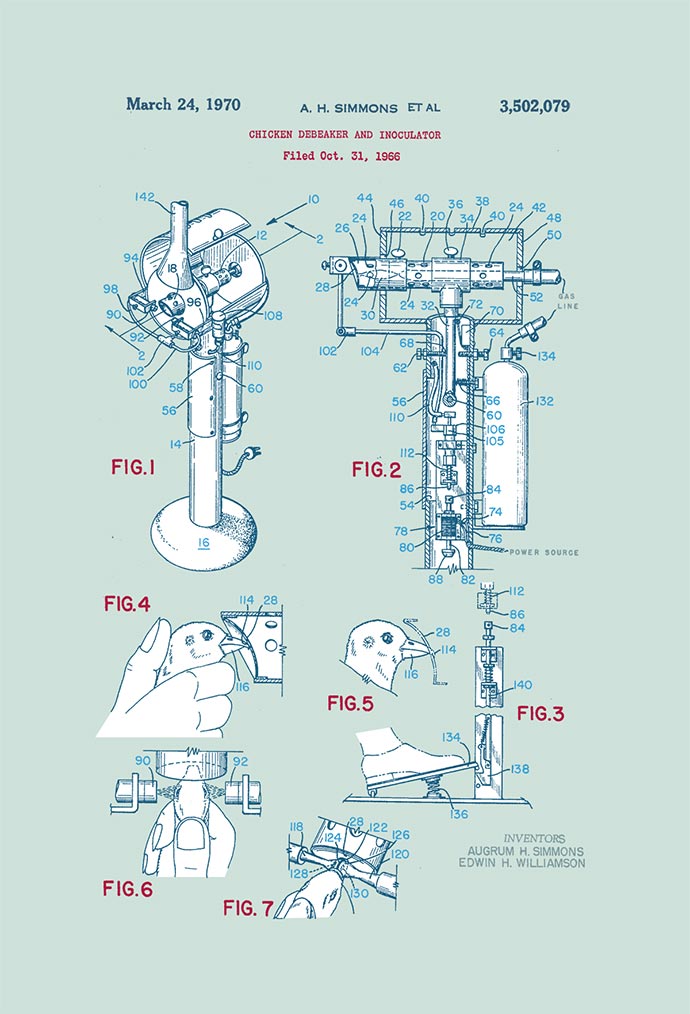
This machine trims a chick’s beak while inoculating the bird.
© Christopher Dang/Timeline.com
As the broiler industry became increasingly industrialized, more machines addressed the challenge of processing thousands of chicks in a short
period of time.
The “chicken debeaker and inoculator” (US patent #3502079 A) enabled an operator to quickly trim and cauterize chicks’ beaks
with a heated blade while inoculating them with an atomized spray against the eyes. One operator could perform two jobs at once.
JULY 1995
First-ever cruelty charges filed against farmer
Green County, KY
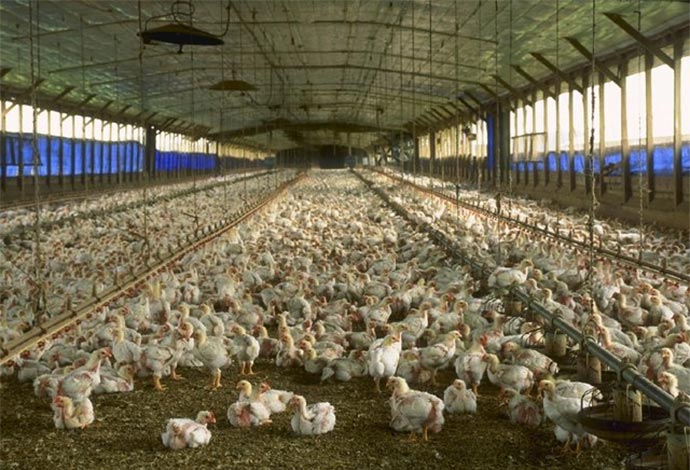
180,000 broilers were left to starve to death in a coop similar to this one.
© US Department of Agriculture
Wilson-Fields, Inc., a Kentucky poultry company that had gone bankrupt, failed to feed 180,000 broiler chickens, leaving them to slowly die of
starvation.
Animal rights group PETA (People for the Ethical Treatment of Animals) brought the case to court, and the Green County grand jury indicted
Douglas Gossman, president of Wilson-Fields, for cruelty to animals in the second degree: a Class A misdemeanor. This was the first case of its
kind, and Gossman ultimately pleaded guilty.
2005
Ross 308 broiler breed developed
Huntsville, AL
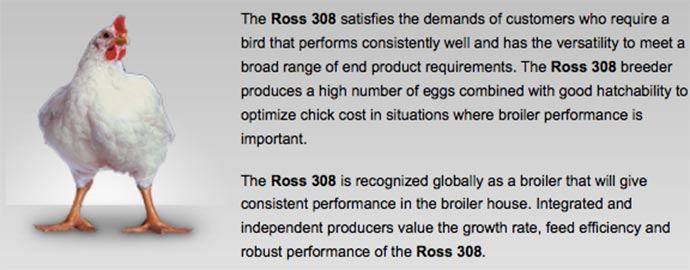
The Ross 308 broiler is now the most common breed in the US. © Aviagen
Alabama-based Aviagen developed the Ross 308 broiler, a breed that grows to be about four times the size of a comparable 1957 breed and has
three times the “breast conversion rate,” a measure of grams of feed to grams of meat produced.
In about five weeks, after eating 7.77 pounds of feed, the Ross 308 grows to roughly 5 pounds. According to the journal Poultry Science, if humans grew at the same rate as these modern chickens, a baby would weigh 660 pounds at two months.
Hormones for birds banned
Explained
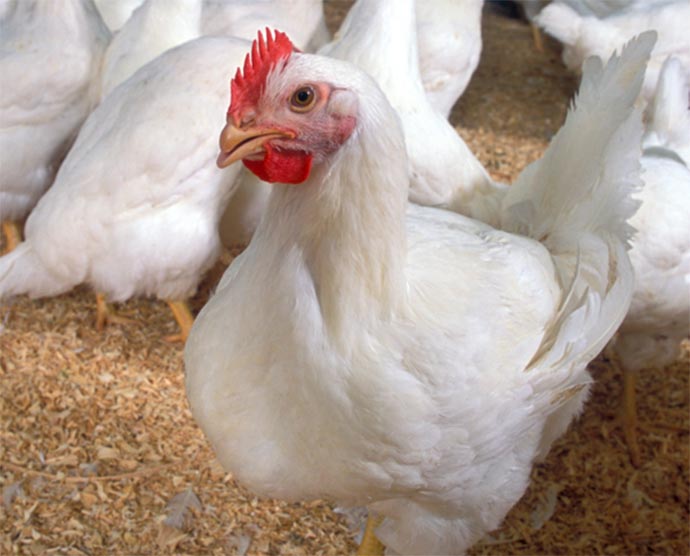
Today’s robust broilers grow large due to selective breeding, not hormones.
© US Department of Agriculture
The use of hormones for poultry in the US has been banned since the 1950s. Aside from being illegal, administering them is impractical. Growth
hormones are proteins, which means they would be broken down through digestion if fed to broilers, and injecting them daily would be a daunting
task considering most broiler farmers keep houses of 20,000 birds.
Today’s broilers grow much larger than the birds of yesteryear due to selective breeding, feeding and environmental control. (Conversely,
the majority of beef cattle in the US do receive growth-promoting hormones.)
JULY 31, 2014
USDA battles bacteria
Washington, DC
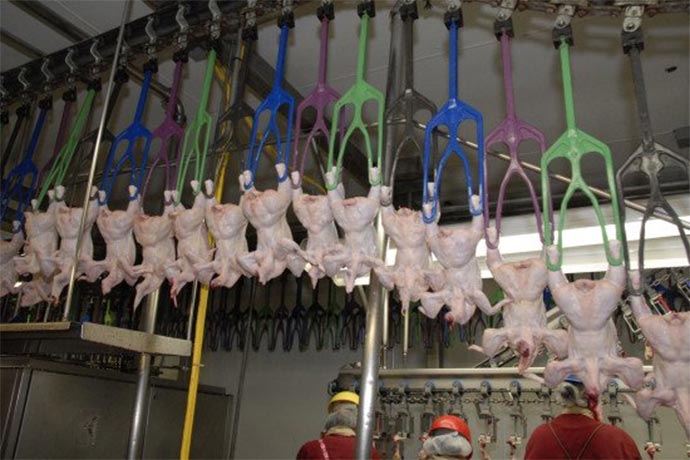
Slaughtered broilers lined up for inspection © Organic Authority
To reduce food-borne illness from poultry, President Barack Obama issued Executive Order 13563 in 2011, requiring the USDA to update its
inspection regulations. The USDA responded in early 2012 with a 379-page proposed New Poultry Inspection System (NPIS) for chicken and turkey
slaughterhouses. NPIS is the latest addition to a regulatory chicken alphabet soup: It doesn’t replace the existing Streamlined
Inspection System (SIS), New Line Speed Inspection System (NELS), or New Turkey Inspection System (NTIS).
NPIS went live in 2014, and like
previous inspection regulations, it demands that production lines run no faster than 140 birds per minute.
JANUARY 1, 2015
Scrambling for eggs
Sacramento, CA
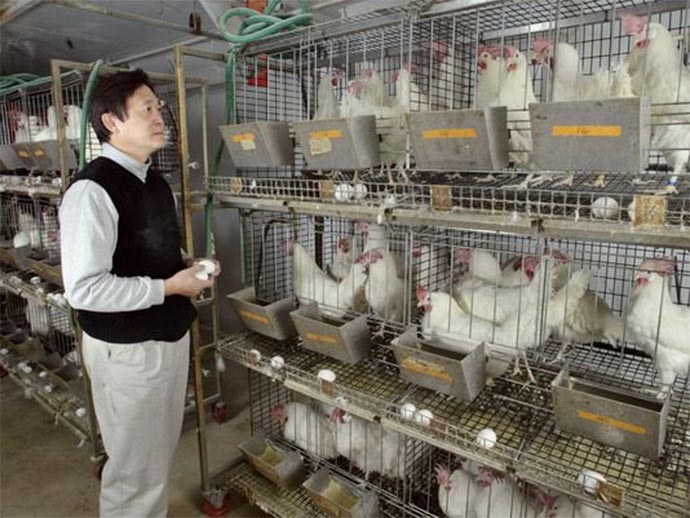
Iowa egg farmers have increased their cage sizes to hit the enormous California market, even though they are technically outside the
range of the regulation. © Mary Willie/Des Moines Register
In an effort aimed at improving poultry welfare, California made it illegal
to sell
eggs from hens who were not able to “lie down, stand up, fully extend their limbs and turn around freely” in their cage.
The law targeted markets in an effort to get around the state’s well-organized farm lobby. In this way it’s successful, but it is
unclear — and tough to determine — if the hens are actually happier.
Want more?
Further reading
Nathanael Johnson wrote on the California egg laws for Grist.
A passionate argument over whether fried chicken
is better hot or cold can be found on the ever-passionate, ever-argumentative Serious Eats.
United Poultry Concerns
promotes the compassionate and respectful treatment of domestic fowl.
If you want to look at the heart (or the gizzards) of the chicken industry, Maryland’s Delmarva Peninsula Chicken Festival is for you.
CURATED BY
Goli Mohammadi
More about this author
COVER PHOTO
Poultry slaughtering machine, patent drawing.
Credit: Christopher Dang/Timeline.com
SOURCE
Timeline.com